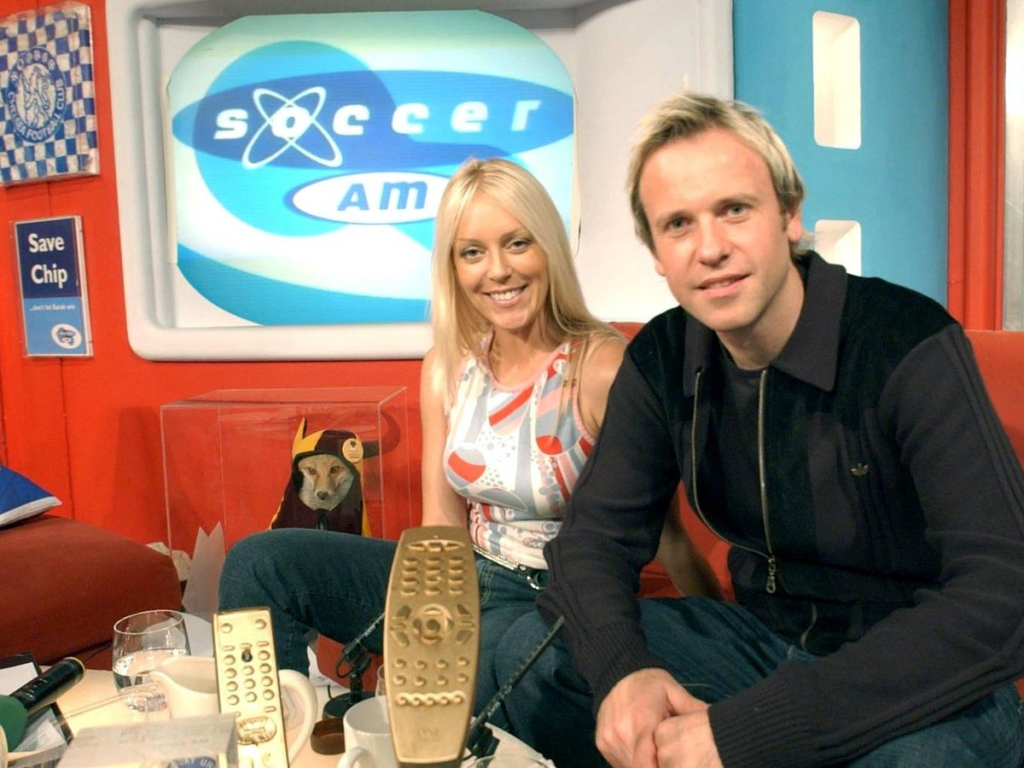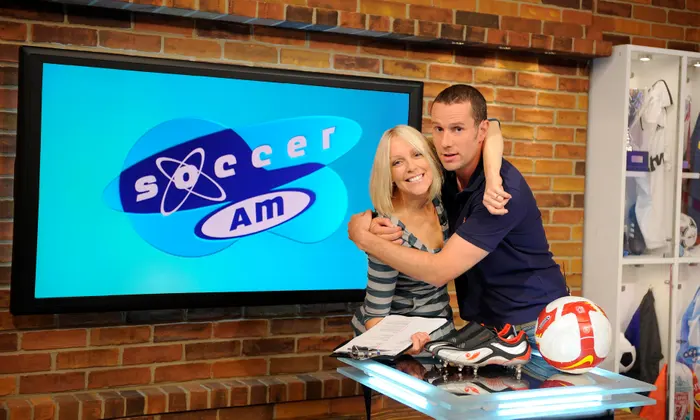Some TV shows just stick with you. This is especially true for sporting programmes, with Match of the Day being mandatory viewing for football fans in England for over half a century. For those of a certain generation, it was all about Grandstand and Football Focus. For those just a touch younger, and those who grew up with satellite TV that wasn’t as all-encompassing as it is today, Soccer AM was THE place to go for morning buildup on a Premier League Saturday.
Is Soccer AM Still Running? Yes. Soccer AM is still running, and it currently airs on Sky Showcase, Sky Sports Premier League, and on Sky Sports Football. It is on air at 10:30 am on Saturday during the football season. The programme has also aired on a slight delay since 2020 for the producers to catch bad language as the show is live and often a little rowdy.

Let’s look at the history of Soccer AM, where it came from, when it was at its peak, and what it is today.
The Early Years
It may seem a little difficult to believe, but Soccer AM started with a similar formula to any normal football program. The year was 1994, and Sky Sports had just begun their second channel (Sky Sports 2) without enough content to fill it. This was still an era where channels would turn off their signal at night (a different world), and sporting content wasn’t nearly as varied as it is today.

The initial lineup was Russ Williams and Helen Chamberlain as the two presenters. Ex=England defender Gary Stevens was the primary guest, while Bradley Walsh spent plenty of time in the studio sharing his opinions. The show took much of its influence from radio, there were phone-in segments where fans could call in with questions and thoughts, and the whole show was presented from a small studio where the hosts would sit in the same spot for the entire four hours. Sky would never admit to such a thing, but Soccer AM was just a programme to fill what would otherwise be dead air.
The Rise of Soccer AM
One hire was all it took to change the direction of Soccer AM and, as a result, the future of football TV in England. In 1996, Williams was moved away from the show to work on broadcasting duties for Sky and their coverage of the Endsleigh League. At the same time, Tim Lovejoy wrote to the broadcasters asking if they had any jobs available. At first, they offered him the roles of producer for Soccer AM and Soccer Extra. This seemed like a lot of work for Lovejoy, especially when taking a pay cut. It looked like the idea was dead in the water.
That is when the presenting job became available. Sky reached out with a new offer, one that would allow Lovejoy the creativity as the producer of the show and the role of host. He snapped it up and immediately set about changing a program format that he saw as boring. Lovejoy had been working on ‘The Big Breakfast’ at the time, and it is clear to see the similarities in the controlled chaos of both Soccer AM and the Channel 4 programme that defined breakfast TV in the 1990s. It was simply the perfect match of creative passion and football at the perfect time.
From the addition of Lovejoy onward, Soccer AM took off. He and Chamberlain anchored the show from 1996 until he left in 2007. Chamberlain stuck around for another 10 years, hosting with the likes of Andy Goldstein, Max Rushden, and John Fendley until she left in 2017. The problem for Soccer AM was that everything that Lovejoy had done made the show as successful as it was. All the features, all the regular segments, it was a programme that built a loyal fanbase that didn’t want to see changes to a format they loved.

The Fall
This is why when Lovejoy left, the show began a downward trend. Chamberlain did her best to keep it together and Goldstein certainly has his fans, but while change was inevitable, it was also painful. A change in producer hurt more than the change in presenter, with Rob Wakeling coming in from kids’ show ‘Dick and Dom in the Bungalow’. Soccer AM was a weird hybrid show with an adult sense of humor in a non-traditional adult time slot, and the marriage between producer and viewer expectations just didn’t work well. Add in that in viewer’s minds no one was going to be able to follow Lovejoy, and the whole period of Soccer AM until a complete revamp occurred in 2015.
That revamp came through the employment of John “Fenners’ Fendley. He came in as producer and presenter and immediately shook things up. Rushden had been there for seven years and he was let go. In Fenners’ mind, Soccer AM had strayed too far away from football and that is why viewers had fallen out of love with it. He brought in comedian Llyod Griffish, who lasted two years, and (importantly) he bought in ex-pro Jimmy Bullard, who has always been known for his legit football based comedy banter.

Bullard is a career overachiever. He played for years in the Premier League, with his cheeky personality either making him loved or loved to be hated. His chemistry with Fenners, and his clear love of the game and presenting, is one of the main reasons why Soccer AM has once again become appointment TV as we move through the 2020s.
Segments
- Fans of the Week – Eight fans of a team were invited in to feature on various aspects of the show. Introduced in 1997, this one feature (more than any other) was what propelled Soccer AM to cult status.
- Soccerette – A segment of its time. Fans could win the Soccer AM T-shirt worn by the Soccerette by correctly guessing the number of goals scored in the Car Park Challege (a challenge changing yearly for the Fans of the Week to score.
- Shocker Saturday – A riff of Soccer Saturday, the Sky Sports News’ Soccer Saturday show made famous by Jeff Stelling, this is a way to mock both soccer and non-soccer clips in a viral fashion.
